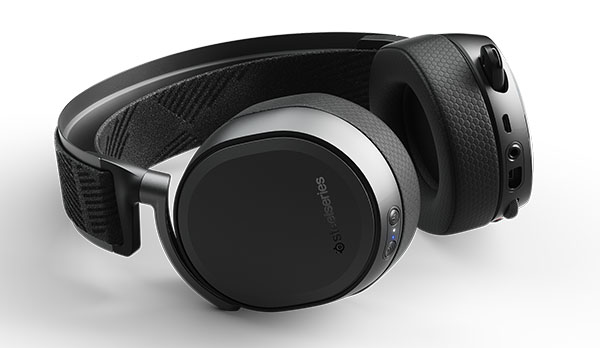SteelSeries Acquires A-Volute, Company Behind Nahimic Audio Software
by Gavin Bonshor on April 7, 2020 5:30 PM EST- Posted in
- Audio
- Software
- Peripherals
- SteelSeres
- A-Volute
- Nahimic

Danish peripherals and gaming headset manufacturer SteelSeries has announced its acquisition of A-Volute, the independent developer of the Nahimic audio software. The Danish manufacturer is looking to take full advantage of A-Volutes' experience to bolster its audio range, with its Arctis series already established in the gaming headset market.
SteelSeries is no stranger to the peripherals market, with experience spanning over the best part of two decades. The company has seen successful product launches, and its popular products including its World of Warcraft branded gaming mice. So in a bid to boost its audio range which is spearheaded by its premium Arctics range, it has acquired A-Volute.

SteelSeries Arctis Pro Wireless Hi-Fidelity Gaming Headset
A-Volutes' portfolio is impressive and its software is used by many system integrators, including Dell, GIGABYTE, and MSI. For those unfamiliar with it, the Nahimic audio software allows users to setup various audio enhancements/adjustments via with a control panel application. Among other things, the Nahimic software can provide virtual surround sound mixing, as well as audio equalization settings including bass, treble, and voice when used with a microphone. It remains to be seen how SteelSeries is looking to implement Nahimic into its gaming products, but its Arctis Pro comes with a GameDAC which could shed some light on possible use case scenarios.

The Nahimic 3 Audio Control Panel bundled with the MSI MEG X570 Godlike Motherboard
Current SteelSeries CEO Ehtisham Rabbani said this about its purchase of A-Volute:
"With our award-winning innovations that have redefined the gaming audio experience, and our best-in-class SteelSeries Engine software, bringing A-Volute into the SteelSeries family seemed like a natural fit and we are extremely excited about partnering with Tuyen and his team,” said Ehtisham Rabbani, CEO of SteelSeries. “With their excellence in audio software, they’ll help us improve gamers’ audio experiences even further".
No details regarding the financials of the transaction have been revealed, but SteelSeries says the deal will close later on this spring.
Related Reading
Source: SteelSeries










24 Comments
View All Comments
cosmotic - Tuesday, April 7, 2020 - link
Cool! It's like 1998 when Aureal A3D was around before Creative killed it.quorm - Tuesday, April 7, 2020 - link
What's the current status of pc 3d audio? I remember having a vortex card with a breakout board (extra ram, maybe?). Can standard onboard audio do 3d effects like occlusion now?brucethemoose - Tuesday, April 7, 2020 - link
I'm pretty sure the CPU handles all that these days. So some games are better than others, and most are... not great.But MS and Sony are making a big deal about audio specific silicon in the PS5/XSX. I doubt we'll go back to accelerator boards, but I wouldnt be suprised to see big audio processing blocks snuck into other hardware, like Realtek's chips, or maybe even GPUs/CPUs if MS pushes a DirectX audio thing.
AMD briefly shiped some "Trueaudio" GPUs with dedicated DSPs around 2013, and the tech was allegedly part of the PS4. But nothing came of it.
mode_13h - Wednesday, April 8, 2020 - link
AMD added a custom audio processor block to some of its early GCN GPUs, which I think they licensed from Tensilica. Later, they removed it and added some QoS features to GCN, so that the GPU's general-purpose cores could be used for audio processing.drexnx - Tuesday, April 7, 2020 - link
Microsoft killed it in Vista, hasn't come back since.Samus - Friday, April 10, 2020 - link
It had a lot to do with not having the open IP to integrate it into DirectX. Though the patents have probably expired, A3D isn't anything revolutionary anymore as CPU's are so powerful they can play the audiospace placement game perfectly. But the problem is there is no standard. DirectAudio still doesn't have an "A3D" API so all games have a priprietary system, and as Bruce mentioned, some games are clearly better than others. Battlefield, IMHO, easily has (subjectively) on-par audio placement with A3D using Dolby mode on my SteelSeries H headphones (the best gaming headphones I've ever owned)linamking9 - Thursday, April 16, 2020 - link
Make 6150 bucks every month... Start doing online computer-based work through our website. I have been working from home for 4 years now and I love it. I don't have a boss standing over my shoulder and I make my own hours. The tips below are very informative and anyone currently working from home or planning to in the future could use this website…... https://2.gp/a71FfScabies - Tuesday, April 7, 2020 - link
Does this mean the return of a tolerable Realtek control panel?Dragonstongue - Wednesday, April 8, 2020 - link
MSI requires Nahimic to be used to "properly" use Realtek audio, yet, in my case (as well as going by their forums) hundreds if not thousands that it does NOT work the way it should be..could maybe explain why everything "was" working for many many months in my case, to all of a sudden no longer functioning properly, which led me to use "default" Win10 generic provided audio drivers.MSFT forces folks to get the drivers from the store, yet, do that, and functions worse if any at all vs the generic drivers.
audio works, I suppose that is ok, but not at all the way it should be either.
would it be "that complicated" to provide the drivers required to make it work properly without the @#$ headache associated...if they bought A Volute, does that mean MSI will now have to pay Steelseries to use something folks have to use, or maybe Steelseries will make sure it works properly?
HA HA..doubt it on the last part, SS known to "kill" what was very desirable vs chasing highest ASP products
sign of the times I suppose, lots of flash with little substance to back it up
PaulHoule - Wednesday, April 8, 2020 - link
I am deeply skeptical of software that comes with headphones.Frequently it doesn't work at all (no sound) or it crashes the audio subsystem of the OS, or if it does "work", the sound it is supposedly putting above your head just makes my head feel pinched. Maybe people learn to know what direction the sound is supposed to come from in a psychophysical test by learning how to hear where the notches in the filter. On top of it, the GUI is guaranteed to be a mess, first in that you'll have to bypass the "user friendly" settings dialogs that come with windows, go mess with the tired and confusing and half-baked old control panels for sound, then it also has a razeriffic GUI which might render correctly on a good day.
They'll have to convince anyone who's already tried a headphone with software that this is not value subtraction, and also satisfy investors that the merger isn't value destruction.